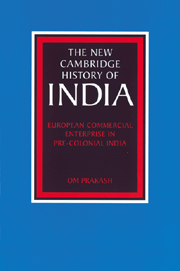Book contents
- Frontmatter
- Dedication
- Contents
- List of figures
- List of maps
- List of tables
- General editor's preface
- Preface
- Introduction
- 1 India in the Indian Ocean trade, circa 1500
- 2 The Portuguese in India, 1500–1640
- 3 The European trading companies: exports from Europe and the generation of purchasing power in Asia
- 4 The companies in India: the politics and the economics of trade
- 5 Euro-Asian and intra-Asian trade: the phase of Dutch domination, 1600–1680
- 6 The VOC and the growing competition by the English and the French, 1680–1740
- 7 The supremacy of the English East India Company, 1740–1800
- 8 European trade and the Indian economy
- 9 Conclusion
- Bibliographic Essay
- Index
- Misc-endmatter
- Map 1 Important trading centres in Asia in the seventeenth and eighteenth centuries"
- Map 2 Portuguese seaborne empire, c. 1580"
- Map 3 The Indian Ocean in the seventeenth and eighteenth centuries, showing the settlements of the English East India Company and of other European nations"
- Map 4 India: main textile–weaving areas, 1600–1750"
Preface
Published online by Cambridge University Press: 28 March 2008
- Frontmatter
- Dedication
- Contents
- List of figures
- List of maps
- List of tables
- General editor's preface
- Preface
- Introduction
- 1 India in the Indian Ocean trade, circa 1500
- 2 The Portuguese in India, 1500–1640
- 3 The European trading companies: exports from Europe and the generation of purchasing power in Asia
- 4 The companies in India: the politics and the economics of trade
- 5 Euro-Asian and intra-Asian trade: the phase of Dutch domination, 1600–1680
- 6 The VOC and the growing competition by the English and the French, 1680–1740
- 7 The supremacy of the English East India Company, 1740–1800
- 8 European trade and the Indian economy
- 9 Conclusion
- Bibliographic Essay
- Index
- Misc-endmatter
- Map 1 Important trading centres in Asia in the seventeenth and eighteenth centuries"
- Map 2 Portuguese seaborne empire, c. 1580"
- Map 3 The Indian Ocean in the seventeenth and eighteenth centuries, showing the settlements of the English East India Company and of other European nations"
- Map 4 India: main textile–weaving areas, 1600–1750"
Summary
The rise of a pre-modern world economy, facilitated by the great discoveries of the closing years of the fifteenth century, held important implications for the Indian subcontinent. The availability of an all-water route between Europe and Asia via the Cape of Good Hope, and of a growing amount of American silver for export to Asia, involved a substantial expansion in the volume and the value of Euro-Asian trade. The Portuguese monopoly of the all-water route was challenged at the beginning of the seventeenth century by the English and the Dutch East India companies, who eventually came to dominate this trade. The only other body of any consequence engaged in this enterprise was the French East India Company. The so-called minor companies — the Danish, the Ostend, the Swedish and others - never really accounted for more than an insignificant proportion of the total trade between the two continents. At least one of the corporate enterprises, namely the Dutch East India Company, also carried on a substantial amount of trade within Asia. Employees of corporate enterprises also engaged in intra-Asian trade in their private capacity. By far the most important category of these employees was that in the service of the English East India Company.
- Type
- Chapter
- Information
- European Commercial Enterprise in Pre-Colonial India , pp. xvi - xviiiPublisher: Cambridge University PressPrint publication year: 1998

